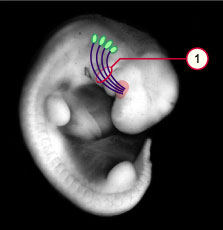|

1
|
Hypoglossal cellular cord |
|
|
|
Fig. 17
The embryo is in stage 14, ca. 33 days. The occipital somites are depicted in green. The tongue receives material from all 4 occipital somites for muscle formation. The connective tissue and the myoblasts together form a hypoglossal cord.
|

